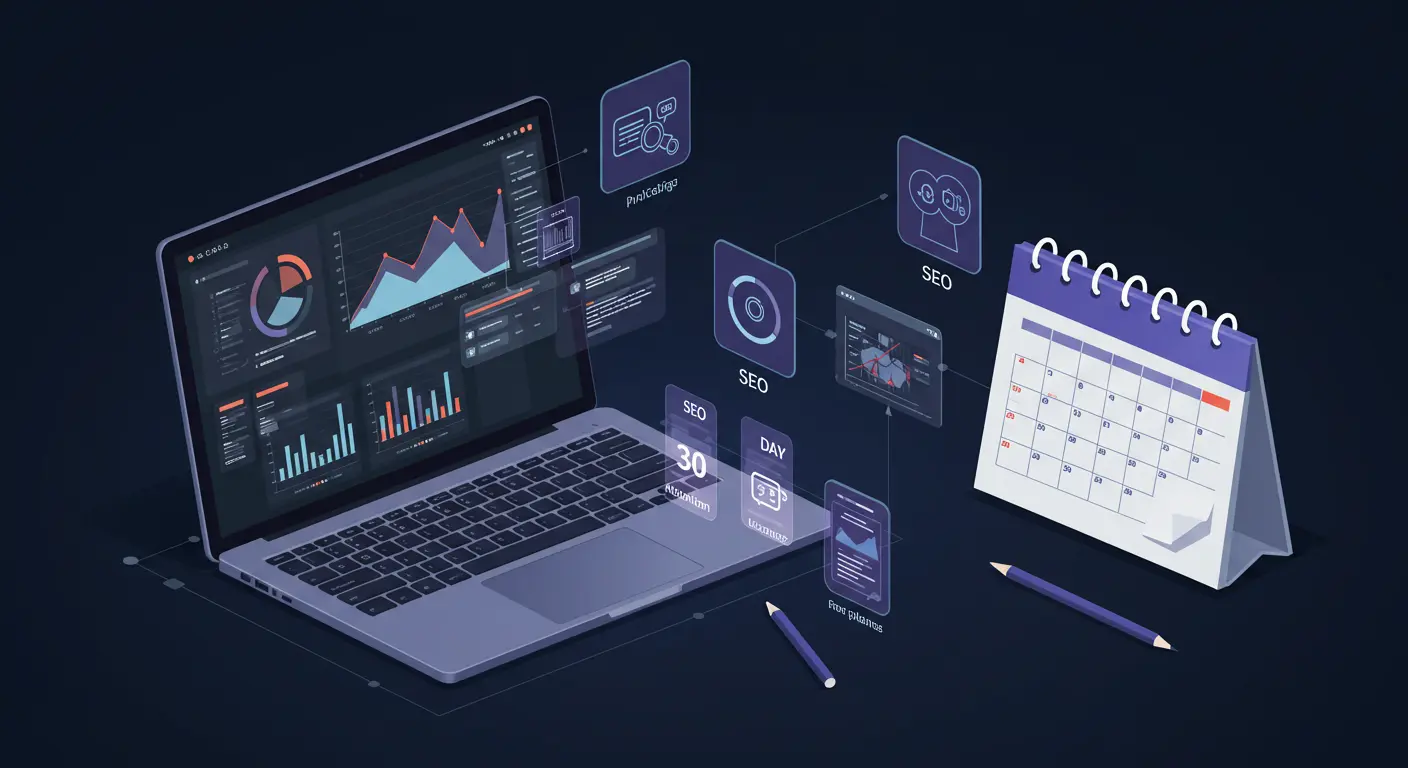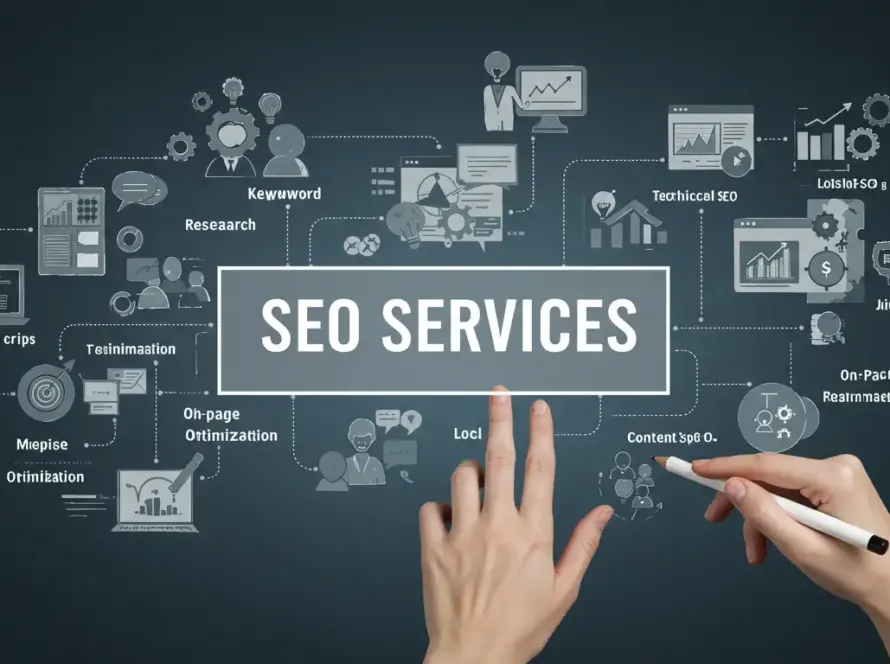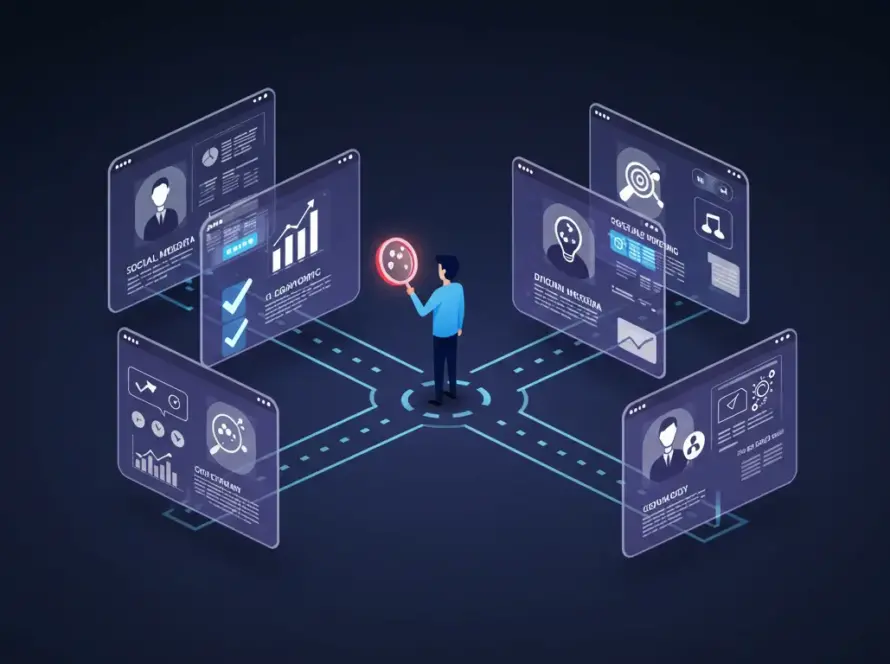You’ve probably heard a hundred different tips on what to do online, post on social, run ads, send emails, go viral. But without a real strategy, it all turns into noise.
Digital marketing in 2025 moves fast, but success still comes down to doing the basics well. You don’t need to be on every platform or chase every new tool. You just need a clear plan that connects with the right people, in the right places, with the right message.
This guide breaks down exactly how to build that plan step by step. You’ll also learn what’s changing this year, common pitfalls to avoid, and how to get off to a strong start in just 30 days.
Building Your Digital Marketing Strategy (The Step-by-Step)
It’s easy to get lost in all the tools, trends, and platforms. But a good strategy doesn’t start with a platform, it starts with a plan. Here’s how to build one that actually works in 2025.
Step 1: Get Clear on Your Goals
Wanting “more sales” is too vague. You need to set goals that are specific, trackable, and realistic.
The SMART method (Specific, Measurable, Achievable, Relevant, Time-based) is still useful if you keep it simple. According to CoSchedule, marketers who set clear goals are 376% more likely to report success.
Here are a few solid goal examples:
- Grow your email list by 25% in the first quarter
- Improve your website’s conversion rate by 15% over three months
- Get 1,000 visits from organic search in the next 30 days
Knowing what you’re aiming for helps everything else fall into place.
Step 2: Know Your People (Your Target Audience)
Marketing isn’t just about reaching everyone. It’s about reaching the right people.
Demographics like age and gender help, but they don’t tell the whole story. You need to know what your audience cares about, what frustrates them, and where they spend time online.
Look at:
- What platforms they use most
- What questions they’re asking in search
- What makes them stop scrolling and pay attention
And map out their journey. Are they just hearing about you? Are they comparing options? Are they ready to buy?
Knowing where they are helps you show up with the right message.
Step 3: Choose Your Channels Wisely
You don’t need to be on every platform. Just the right ones.
If you’re a B2B brand, LinkedIn might work better than Instagram. If you’re selling lifestyle products, visual platforms like Instagram or Pinterest might be the place to focus.
Start small. Pick one or two places where your audience hangs out. Test what works, then build from there.
And always watch the return and not just the likes. One good lead is worth more than a hundred shares.
Step 4: Create Content That Doesn’t Suck
Content is still king, but not just any content. People don’t want to be sold to. They want to learn, laugh, or feel something. HubSpot’s 2024 report found that 83% of marketers who prioritize quality content see positive ROI.
Think about:
- Helping them solve a problem
- Answering a question they’re already asking
- Inspiring them to try something new
In 2025, AI can help with creating and repurposing content. One blog post can become a short video, a few social posts, and an email series.
But tools won’t save you if the message doesn’t matter. Focus on quality, stay consistent, and aim to be useful.
Step 5: Measure Everything (But Focus on What Matters)
You can track almost everything online. But not everything is worth your time.
Vanity metrics like likes or views feel good, but they don’t always lead to sales. Focus on the numbers that drive your business forward.
Start with these:
- Website traffic
- Conversion rate
- Actual revenue or leads
Use tools like Google Analytics, email insights, and platform dashboards to understand what’s working. Then improve based on what the data tells you.
Step 6: Automate the Boring Stuff
Some tasks take too much time to do manually every day. That’s where automation saves you. On average, marketing automation boosts productivity by 20% and increases conversion rates by 53% (Invesp, 2023).
You can automate:
- Welcome emails
- Post scheduling
- Cart recovery reminders
- Lead scoring
But not everything should be automated. Customer service, creative ideas, and real conversations still need a human touch.
It takes some setup at the start, but once it’s rolling, it gives you time back to focus on the big stuff.
Step 7: Stay Agile
Platforms change. Algorithms shift. What worked last year might flop this year.
The best digital marketers stay curious and flexible. Try new things, test often, and don’t get stuck in one way of doing things.
Keep a few habits:
- Run simple A/B tests
- Ask your audience what they want
- Watch how they actually behave, not just what they say
Staying flexible is what keeps your strategy from falling behind.
The 2025 Digital Marketing Landscape
The online world is changing fast. Here’s what marketers should watch, what’s shifting, and what remains steady.
Emerging Trends to Watch
1. Authentic creator partnerships
Brands are partnering with creators who truly connect with their audience. These real voices build trust far better than paid influencers who feel out of touch.
2. Weather‑based advertising
Tools like WeatherAds let brands trigger ads when the weather changes like promoting umbrellas during rain. Advertisers can target based on conditions at specific locations, and many start plans as low as $99 per month to test out this timely method.
3. Social platforms as entertainment hubs
Apps like TikTok, Instagram, and YouTube are becoming the default places people go for entertainment, news, and shopping.
4. Sustainability messaging
Today’s consumers want to know how brands affect the planet. Clear and honest environmental stories are becoming non-negotiable.
What’s Changing
Search isn’t just Google anymore
People use AI-powered tools and voice assistants. Results need to sound natural, answer questions clearly, and adapt to this new style of searching.
Privacy-first landscape
Third-party cookies are on their way out. Chrome paused the plan for now, but privacy-focused browsers like Safari and Firefox have already blocked them. That means more emphasis on first-party data and privacy-safe tracking.
Video keeps growing
Short-form video remains king. It’s no longer optional. It’s essential across platforms in any solid strategy.
AI-powered predictive analytics
By 2025, 95% of companies are using AI-driven analytics in marketing, with 44% fully integrated into their systems. Predictive tools boost forecasting accuracy by nearly 47%, and 65% of executives say it will be a primary source of growth.
What’s Staying the Same
Quality content still wins
No matter how tech changes, stories that help, entertain, or move people will always work.
Relationships matter
People buy from businesses they trust. Online trust builds slowly and can’t be rushed.
Data drives decisions
Trust your numbers and not gut feelings. Good use of analytics still separates the average from the great.
Mobile-first is non-negotiable
Everyone uses their phone. Your presence needs to work on small screens and fast connections every time.
Common Mistakes (And How to Avoid Them)
Every marketer makes mistakes, especially in a space that changes so fast. But most of these slip-ups can be avoided with a bit of awareness and some small adjustments.
One of the most common missteps is what people call the “spray-and-pray” approach. It happens when businesses try to be on every platform at once—posting on Instagram, tweeting daily, running Facebook ads, starting a blog, and even jumping into TikTok—without a clear plan. Instead of doing a few things well, everything feels rushed and scattered. The smarter move is to pick two or three channels where your audience actually spends time, and put your energy there. You’ll see better results by going deeper instead of wider.
Another mistake is forgetting about the people who already bought from you. It’s easy to get caught up in chasing new customers, but ignoring your existing ones can hurt long-term growth. Returning customers are often the most loyal, and keeping them happy costs less than attracting new ones. Whether it’s a simple thank-you email, a discount for repeat purchases, or a loyalty program, small touches go a long way in keeping people around.
Then there’s the habit of setting and forgetting. Some businesses launch a campaign and then just leave it running without checking how it’s performing. The problem with this is that marketing isn’t a one-time task. It’s something you revisit regularly. To get the best results, you need to test, tweak, and adjust along the way. If something’s not working, fix it early instead of wasting time and money.
Finally, many people focus on the wrong metrics. They celebrate likes, views, and followers without thinking about what those numbers really mean. These stats might look good on a report, but if they don’t lead to sales, leads, or customer growth, they’re not helping your business. Always ask yourself: “Is this number helping me make a better decision?”
Avoiding these mistakes doesn’t require a big budget or expert-level knowledge. It just means slowing down, staying focused, and paying attention to what truly moves the needle.
Getting Started: Your First 30 Days
If you’re new to digital marketing or starting fresh, the first month can feel overwhelming. But with a bit of structure, you can build real momentum without burning out. Here’s a simple week-by-week approach to help you get going with clarity and confidence.
Week 1:
Week 1 is all about building your foundation. Start by defining your goals. Be specific, whether it’s getting more website visits, collecting leads, or increasing sales. Next, figure out who your target audience is. Who are you really trying to reach, and what do they care about? Once that’s clear, audit your current digital presence. Look at your website, social media, and any past campaigns to see what’s working and what needs attention. Then, choose two or three channels to focus on for now. Don’t spread yourself thin. Pick the ones where your audience actually spends time.
Week 2:
Week 2 is when you begin planning your content. Start by creating a simple content calendar. Just know what you’re going to post, when, and where. Set up basic analytics like Google Analytics or built-in platform insights so you can track what’s happening. Lastly, begin building your email list. Whether it’s through a simple sign-up form or offering something helpful in return, start collecting those contacts early.
Week 3:
Week 3 is when you start implementing. Launch your first campaign, even if it’s small. This could be a paid ad, a blog post, or a new offer on your site. Begin creating helpful, valuable content that speaks to your audience’s needs. And don’t just post and disappear. Engage with your audience. Reply to comments, answer messages, and show people there’s a real person behind the screen.
Week 4:
Week 4 is for reviewing and adjusting. Look at your early results. What’s getting attention? What’s falling flat? Use that information to tweak your approach. Maybe you’ll shift your posting times, change your messaging, or double down on what’s working. Then, map out a plan for the next month based on what you’ve learned.
Starting small and being consistent is better than trying to do everything at once. Give yourself room to test, learn, and grow. Digital marketing is a long game, but your first 30 days can set the tone for long-term success.
Conclusion
Digital marketing in 2025 doesn’t reward being everywhere, it rewards being effective. It’s not about doing it all. It’s about doing the right things consistently, with purpose.
Start with real goals. Know your audience deeply. Pick platforms that make sense, not just the ones trending this week. Create helpful content, track what matters, and automate where you can. Stay flexible, because what works today might shift tomorrow.
If you avoid the usual traps and build slowly but smartly, your digital presence won’t just grow but LAST.



